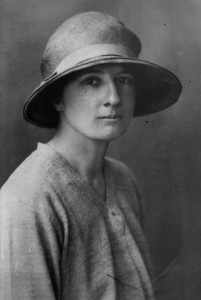Ina Boyle

Ina Boyle (8 March 1889 – 10 March 1967) was an Irish composer.[1] She was born in Bushey Park near Enniskerry and took violin and cello lessons as a child. She studied counterpoint, harmony and composition with Drs. Kitson and Hewson in Dublin, and by correspondence with her cousin Charles Wood. She also traveled to London periodically for lessons with Ralph Vaughan Williams.[2] She also studied with Percy Buck.[3]
Because of her isolation, Boyle's music was seldom performed. However, she continued to compose until her death.[4][5] Her composition The Magic Harp received a Carnegie award, and she won an Olympic Honorable Mention in 1948 for Ireland with Lament for Bion, a composition she submitted to the Olympic Cultural Activities Committee.[6] She died of cancer in Enniskerry, and her papers are housed in the Library of Trinity College, Dublin.[7]
A feature length documentary about the life and music of Ina Boyle titled From the Darkness was broadcast 12 June 2010 on Ireland's RTÉ Lyric FM.[8]
Works
Boyle composed choral works, part-songs, three ballets, a string quartet, song cycles, concertos for orchestra and for chorus and orchestra. Selected works include:
- Soldiers at Peace for chorus and orchestra, 1916
- The Magic Harp - orchestral rhapsody (1919) (Carnegie award)
- Colin Clout - pastoral for orchestra (1921)
- Gaelic Hymns - unaccompanied choral work (1923–1924)
- Symphony No. 1, Glencree (1924–1927)
- Phantasy for violin and chamber orchestra (1926)
- Psalm for cello and orchestra (1927)
- Symphony No. 2, The Dream of the Rood (1929–1930) after the Anglo-Saxon poem
- Virgilian Suite, ballet suite for small orchestra (1930–1931) based on the Eclogues of Virgil
- Overture (1933–1934)
- String Quartet in E minor (1934)
- Concerto for violin and orchestra (1935)
- The Dance of Death - a masque for dancing (1935–1936) after the woodcuts by Hans Holbein
- The Vision of Er, a mimed drama or ballet (1938–1939) based on Plato's Republic, Book X
- Wild Geese, sketch for small orchestra (1942)
- Symphony No. 3, From the Darkness for contralto and orchestra (1946–1951) words by Edith Sitwell
- Maudlin of Paplewick, pastoral opera for solo voices with chamber orchestra (1964–1966) based on 'The sad shepherd' of Ben Jonson[7]
References
- ^ Sadie, Julie Anne; Samuel, Rhian (1994). The Norton/Grove dictionary of women composers.
{{cite book}}:|format=requires|url=(help) - ^ Williams, Ralph Vaughan; Cobbe, Hugh (2008). Letters of Ralph Vaughan Williams 1895-1958.
- ^ Contemporary Music Centre, Ireland: Composers
- ^ Foreman, Lewis (1998). Vaughan Williams in perspective: studies of an English composer.
- ^ Fuller, Sophie (1994). The Pandora guide to women composers: Britain and the United States.
- ^ "COMPÉTITIONS D'ART" (PDF). Retrieved 1 February 2011.
- ^ a b "INA BOYLE (1889-1967)". Retrieved 1 February 2011.
- ^ "From the Darkness". Retrieved 29 November 2011.
